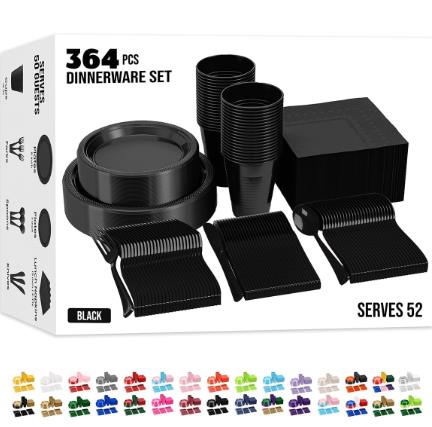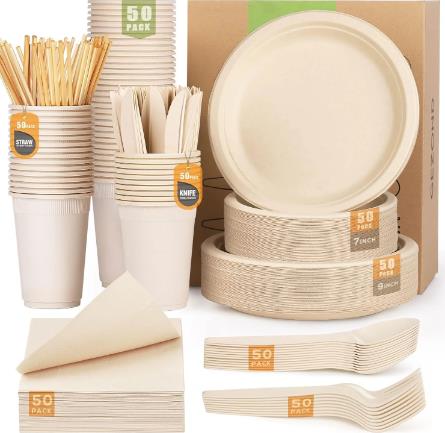
Content Menu
● What Are Disposable Plates?
● Types of Disposable Plates
>> Plastic Plates
>> Paper Plates
>> Bamboo Plates
>> Styrofoam Plates
● Cultural Significance
● Environmental Impact
>> The Rise of Eco-Friendly Alternatives
● Choosing the Right Disposable Plates
● Conclusion
● FAQ
>> 1. What is the Spanish term for "disposable tableware"?
>> 2. Are all disposable plates recyclable?
>> 3. What are some eco-friendly alternatives to traditional disposable plates?
>> 4. How long does it take for plastic disposable plates to decompose?
>> 5. Can paper disposable plates be composted?
When it comes to hosting events, parties, or even casual meals, the use of disposable plates has become increasingly popular. They offer convenience and ease of cleanup, making them a go-to choice for many. In Spanish, "disposable plates" translates to "platos desechables." This article explores the various aspects of disposable plates, including their types, materials, environmental impact, cultural significance in Spanish-speaking countries, and tips for choosing the right disposable plates for your needs.

What Are Disposable Plates?
Disposable plates are single-use dinnerware items that are designed to be thrown away after use. They are typically made from various materials, including:
- Plastic: Commonly used due to its durability and low cost.
- Paper: Often used for picnics and casual gatherings.
- Bamboo: An eco-friendly alternative that is gaining popularity.
- Styrofoam: Lightweight and inexpensive but not environmentally friendly.
Types of Disposable Plates
There are several types of disposable plates available in the market. Each type serves different purposes and comes with its own set of advantages and disadvantages.
| Type | Material | Advantages | Disadvantages |
| Plastic | Polypropylene | Durable, waterproof | Non-biodegradable |
| Paper | Recycled paper | Biodegradable, lightweight | Not waterproof |
| Bamboo | Bamboo fiber | Eco-friendly, compostable | More expensive than plastic |
| Styrofoam | Polystyrene | Lightweight, inexpensive | Environmental concerns |
Plastic Plates
Plastic plates are perhaps the most common type of disposable plate. They are favored for their strength and ability to hold various foods without leaking or bending. However, their environmental impact is significant. Many communities have begun to ban single-use plastics altogether due to pollution concerns.
Paper Plates
Paper plates are often seen as a more environmentally friendly option compared to plastic. They are biodegradable and can decompose within a few months under the right conditions. However, many paper plates come with a plastic coating that makes them less eco-friendly.
Bamboo Plates
Bamboo plates are made from natural bamboo fibers and are an excellent alternative for those looking for sustainable options. They are sturdy and can handle hot foods without warping. Additionally, they are compostable and break down naturally in the environment.
Styrofoam Plates
Styrofoam plates are lightweight and inexpensive, making them a popular choice for large gatherings such as picnics or outdoor events. However, they pose significant environmental hazards as they do not decompose easily and can take hundreds of years to break down.
Cultural Significance
In many Spanish-speaking cultures, disposable plates are commonly used during celebrations and outdoor events. They provide a practical solution for large gatherings where traditional dishware may be impractical. For instance:
- Fiestas: During festive occasions such as birthdays or national holidays, "platos desechables" are often used to serve food quickly and efficiently.
- Picnics: In parks or beaches, families frequently opt for disposable tableware to minimize cleanup efforts.
- Street Food Events: In many Latin American countries, street vendors often use disposable plates to serve food quickly to customers on the go.

Environmental Impact
The environmental implications of using disposable plates cannot be ignored. While they offer convenience, many disposable plates contribute significantly to waste accumulation. Here are some key points regarding their impact:
- Plastic Pollution: Traditional plastic plates can take hundreds of years to decompose and often end up in landfills or oceans.
- Resource Depletion: The production of paper plates requires cutting down trees, impacting forest ecosystems.
- Compostable Options: There is a growing market for compostable plates made from materials like sugarcane or bamboo that break down more easily in the environment.
The Rise of Eco-Friendly Alternatives
With increasing awareness about environmental issues, many people are seeking alternatives to traditional disposable plates. Some options include:
- Reusable Plates: Investing in durable dishware that can be washed and reused is an excellent long-term solution.
- Compostable Plates: Choosing products made from renewable resources that can decompose naturally is becoming more popular among eco-conscious consumers.
- Biodegradable Options: Selecting materials that break down more quickly than conventional plastics is essential for reducing waste.
Choosing the Right Disposable Plates
When selecting disposable plates for an event or gathering, consider the following factors:
1. Event Type: For formal events, consider using high-quality paper or bamboo plates that provide an elegant touch. For casual picnics or barbecues, sturdy plastic or Styrofoam may suffice.
2. Food Type: If serving hot foods or liquids, ensure the plates can withstand heat without warping or leaking. Plastic or heavy-duty paper options may be best in this case.
3. Environmental Impact: Opt for biodegradable or compostable options whenever possible to minimize your ecological footprint.
4. Cost Considerations: While eco-friendly products may be slightly more expensive upfront, they can save money in waste disposal costs in the long run.
5. Guest Preferences: Consider your guests' preferences regarding sustainability; many people appreciate efforts to reduce waste.
Conclusion
In conclusion, understanding how to say "disposable plates" in Spanish—"platos desechables"—is just the beginning of exploring their role in our lives. While they provide convenience and ease during events and gatherings, it is crucial to consider their environmental impact and explore sustainable alternatives. As consumers become more eco-conscious, the demand for biodegradable and compostable options is likely to increase.

FAQ
1. What is the Spanish term for "disposable tableware"?
The Spanish term for "disposable tableware" is "vajilla desechable."
2. Are all disposable plates recyclable?
Not all disposable plates are recyclable; many plastic plates cannot be recycled due to the type of plastic used.
3. What are some eco-friendly alternatives to traditional disposable plates?
Eco-friendly alternatives include compostable plates made from bamboo or sugarcane fiber.
4. How long does it take for plastic disposable plates to decompose?
Plastic disposable plates can take hundreds of years to decompose fully.
5. Can paper disposable plates be composted?
Yes, paper disposable plates can often be composted if they do not have plastic coatings.

















